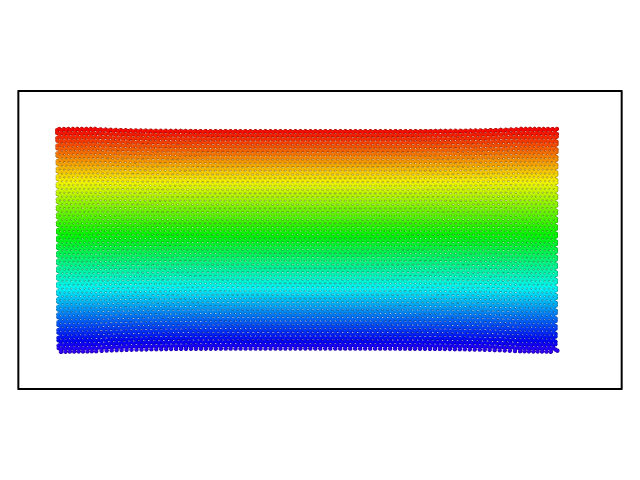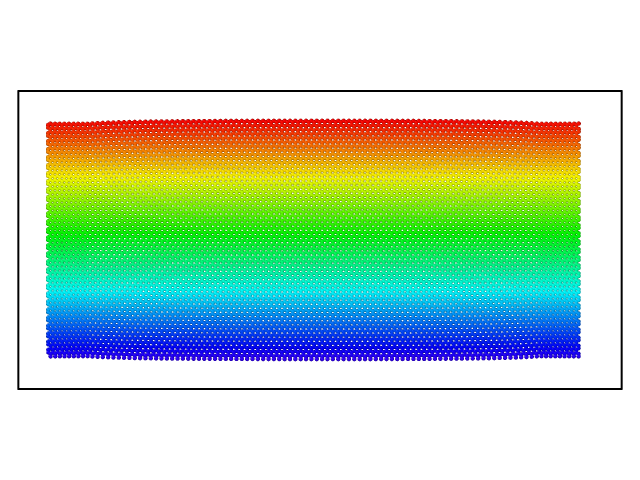Dear Lammps Users.
I use Tersoff and REBO potentials to characterize the carbon atoms in
a single-layer graphene under axial tensiona. And it is believed that
the graphene will have a “necking” deformation due to poission ratio
while two ends are fixed, this is consistent with continuum mechanics.
But I found that only REBO potential gives the “necking” style, the
graphene with tersoff potential gives the totally different
configuration, opposite to “necking” style. which is not reasonable.
I attached my script and deformed shape for REBO and tersoff
potentials here. could you give some comments? Why the tersoff
potential can not give “necking” style, and is there anything wrong
with my script?
Best
Ming Li
Ps: and also, when I run energy minimization, the equilibrium
bond-length is 1.46 angstrom, I remembered that some paper said the
value is 1.45 angstrom.
in_tersoff.cnt (1.79 KB)
data_length_250_strain_00_dat.zip (59.4 KB)
in_airebo.cnt (1.79 KB)


Dear Lammps Users.
I use Tersoff and REBO potentials to characterize the carbon atoms in
a single-layer graphene under axial tensiona. And it is believed that
the graphene will have a “necking” deformation due to poission ratio
while two ends are fixed, this is consistent with continuum mechanics.
But I found that only REBO potential gives the “necking” style, the
graphene with tersoff potential gives the totally different
configuration, opposite to “necking” style. which is not reasonable.
I attached my script and deformed shape for REBO and tersoff
potentials here. could you give some comments? Why the tersoff
potential can not give “necking” style, and is there anything wrong
with my script?
wrong question!
this isn't really a LAMMPS issue, but a science issue. please read the
papers describing the two models and perhaps a few others discussing
the respective benefits and shortcomings. as empirical models, they
cannot be expected to represent *all* properties equally well. which
properties work well and which not so well, is model specific.
you are comparing apples and oranges (REBO and Tersoff), why *should*
they give identical results in the first place? both are two different
models.
Best
Ming Li
Ps: and also, when I run energy minimization, the equilibrium
bond-length is 1.46 angstrom, I remembered that some paper said the
value is 1.45 angstrom.
so what. before wondering some more, please do a few things that
*every* scientist should do when encountering and inconsistency:
*first* you have to figure out what is the error margin for either
model (or error of measurement). as a point of reference, even in ab
initio calculations using DFT, you can see errors of 1-5%. the
difference you worry about is less than 0.7%.
axel.
Dear Axel,
Thanks for your comments,
It is true that this is not a really lammps problem. And actually I
did not want to compare REBO with tersoff potential. The thuth is that
I notice this problem when I use tersoff potential. then, I did a REBO
job as reference.
Basically a membrane structure will have a necking deformation, I
believe this is the same case for graphene. Thus, I doubt that the
simulation with Tersoff potential has the negative deformation is
caused by the minimization. A 2D structure without fully minimization
will have undesired results. Also that’s why I care about the
equilibrium bond length.
But it seems that the system has been fully relaxed, when I stretch
graphene while two ends are fixed, the free edges both have the convex
shape. I want to know why.
Best
Ming Li
[...]
But it seems that the system has been fully relaxed, when I stretch
graphene while two ends are fixed, the free edges both have the convex
shape. I want to know why.
holy gibbs ensemble! batman, it is the riddler again, and i thought we
had already put him away with our last strike.
apparently not, robin. but riddle me this: why do people develop
different models in the first place? why are there different force
fields and even different sets of parameters for the same material
with the same model?
in other words, the models behave the way they do because of the way
they are derived and parameterized. see the literature. if you want a
"true" model without empirical assumptions, you may have to resolve to
ab initio calculations (but many of those are not completely ab
initio, either.)
axel.
OK, I got it.
Thanks for your comments.
Best
Ming Li

